|
The Old Steam Mill
During the 1790s a five storey steam-powered corn
mill was built on the site of the existing mill
building. The original mill is not listed in the
Wolverhampton rate books from 1792, but is listed in
1802, as a ‘committee’ occupying the ‘Old Steam
Mill’.
In the 1818 ‘Staffordshire
General and Commercial Directory’ the occupier is
listed as Joseph Norton, but by the 1830s the entry
had changed to Joseph and James Norton, James being
Joseph’s younger brother.
The site also included the Norton
family’s house, a yard, and two large gardens. In the
1820s, on the
opposite side of Corn Hill, on the site now occupied by
the sack warehouse, was Danks & Company's Wharf. In the
early 1840s it was used by coal merchant
Richard Evans.
|
|
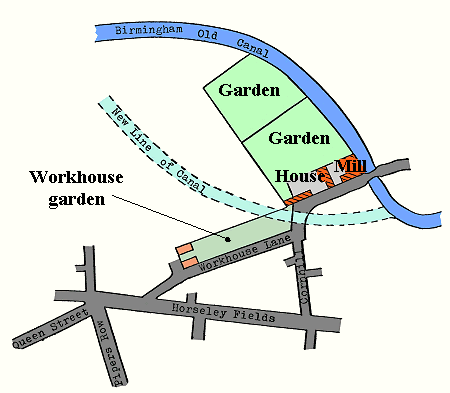
Based on the 1842 Tithe map, with
the canal diversion added. |
In 1851 the mill had two steam
engines, one of which was installed in 1845. So
during the early years the mill must have been
powered by a single engine.
The building on the southern
side of Corn Hill, opposite the mill was the sack
warehouse. It’s the oldest surviving building on the
site, and was used as a warehouse for sacks of
unprocessed and processed grain. The building is not
shown on the 1842 Tithe map, but is marked on a map
from 1852. |
| In 1849 to 1850 when the railway was being built
from Birmingham to Wolverhampton, the canal was
diverted, and the railway acquired the land
containing the Norton family's two large gardens, on
the northern side of the site. The line of the
original canal that ran along the eastern side of
the site was filled-in, except for the first 100
yards or so which remained as a basin serving the
mill. |

A plan of the mill from 1875.
|
Things went very wrong in the
early hours of Thursday 22nd May, 1851 when a severe
fire destroyed the original mill building. The
building was completely destroyed except for the
outer walls, which had to be shored up to prevent
collapse. The two steam engines and boilers were
only slightly damaged, so presumably they were in a
separate building. The house, several store rooms,
and the sack warehouse, were saved.
It appears that the fire which
started on the 4th floor was first spotted by a
boatman who ran up the road to the night watchman
shouting “Fire”. The watchman saw the flames coming
from near the brusher, ran to get some water, but
then found that he could not get near the source of
the fire because of flames and smoke. It is believed
that the fire had been caused by friction in the
machinery.
Four fire engines were called
from Wolverhampton, but there was little that they
could do. They were assisted by local police, and a
detachment of the 50th Foot. The situation was made
worse because the mill was fitted with gas lighting,
and when the gas pipes melted due to heat from the
fire, the gas fed the flames. Around two hours after
the start of the fire, the road was dug up and the
gas main severed, but the fire was not fully
extinguished until Friday afternoon.
At the time the mill contained
12,000 bags of grain, most of which were ruined, and
carried away in canal boats for disposal. The loss
was estimated at between £10,000 and £20,000, only
£8,000 of which was covered by insurance. The
remaining sum had to be found by the Norton family.
|
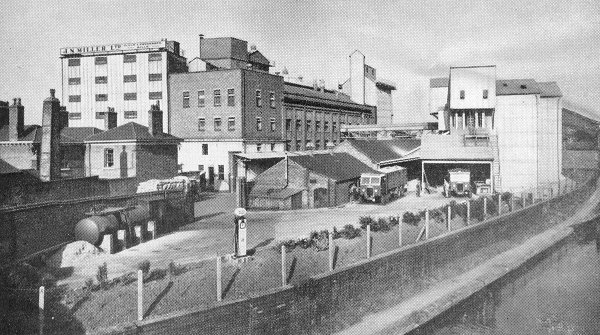
The mill in the 1950s.
|
After the disastrous fire, a
new fireproof mill was designed and constructed by
Fairbairn and Sons of Manchester using the latest
techniques. It had 18 pairs of mill stones, driven
by two steam engines.
From the 1860s the mill is
listed as being run by J. N. Miller – Joseph Norton
Miller. This is because of a marriage between the
Norton and Miller families. The firm also had
premises at Trescott. The firm became a private
limited company in 1907 trading under the name J. N.
Miller Limited.
The original millstones were
replaced by roller mills in 1884, and in 1925 the
steam engines were replaced by electric motors made
by the Electric Construction Company. The
electrification of the mill was carried out by
Christie Brothers of Chelmsford.
In 1910 two rows of silos were
built at the eastern end of the mill. They were
designed by Henry Lovatt and reached up to the third
floor of the mill. The mill used a wide range of
British and foreign grain, dealing with hundreds of
tons of wheat a week. Products included white flour,
national flour, self-raising flour, biscuit flour,
wholemeal flour, bran, and animal and poultry feed.
The mill's products were
delivered to most of the country. Grain arrived by
bulk grain vehicles, and mainly came via the
Liverpool Docks or the Manchester Ship Canal. A high
proportion of the wheat came from Canada, the United
States, Argentina, Australia, Russia, and the Danube
Basin. The remainder came from British farms,
together with barley, oats, rye, and other course
seed grains for animal feed. |
|

An advert from 1970. |
In 1959 Millers ceased to mill
flour, concentrating solely on animal feedstuffs.
The company then advertised the
inclusion of a department for the growing and cleaning
of cereal seeds, and the ability to collect and deliver
all kinds of feeding stuffs and seeds from farms in
bulk.
The mill closed in 1990 and has
remained empty ever since.
In 2004 plans were made to convert
the mill buildings into 49 apartments, but since that
date nothing has happened.
|
| Sadly the buildings have been the victim of two
arson attacks that have put their future in some doubt.
In March 2007 the sack warehouse was badly damaged by
fire, which gutted the inside, and took much of the
roof. Since that time the windows and doors have been
boarded-up, and a gaping hole has been left in the roof.
|
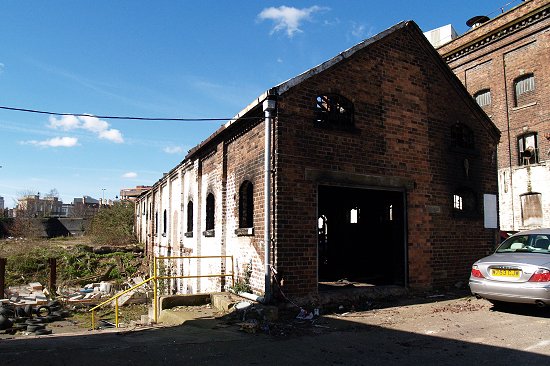
The sack warehouse after the fire.
|
A second and more serious fire,
that has put the future of both buildings in jeopardy,
happened in August 2008 when much of the old mill was
destroyed.
The Grade 2 listed building was
badly damaged, much of the roof has gone, and the
interior at the eastern end has been reduced to a mass
of twisted metal.
Sadly the building was demolished
in 2015.
| Read a more
detailed history of the company. |
 |
|
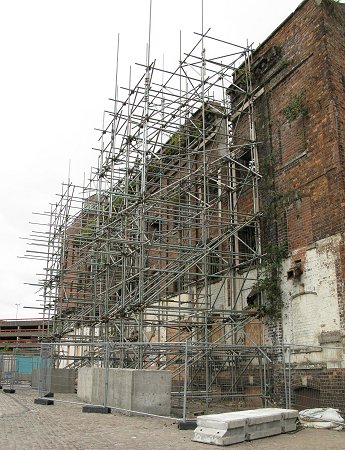
The mill in October 2009. |
|
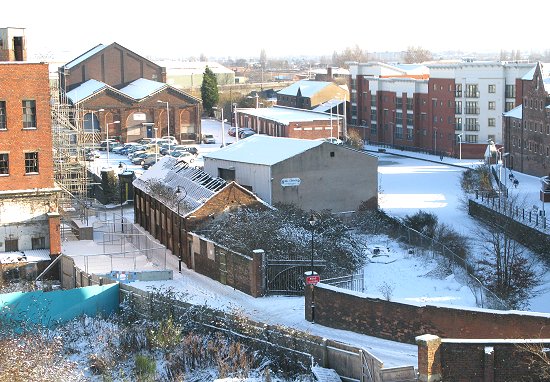
Looking down on Corn Hill and the
mill buildings in January, 2010. |
 |
Return to the
previous page |
|